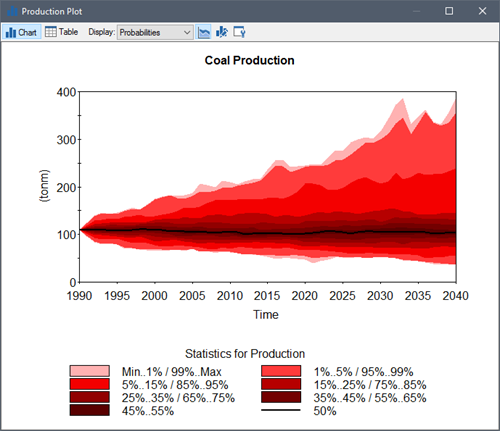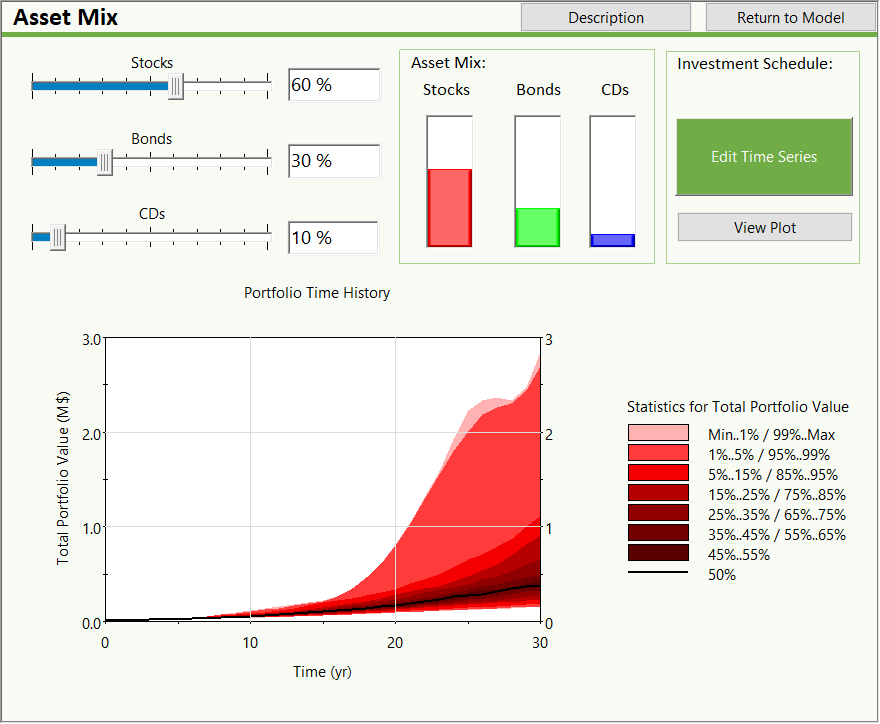Moving Beyond Spreadsheets
How is GoldSim Different from Spreadsheets?
Although spreadsheets are very useful for accounting tasks and making simple projections, they have weaknesses when used for many quantitative modeling tasks. In particular, spreadsheet models are not transparent, are difficult to explain to others, are prone to errors, and are not well-suited to representing complex dynamics.
As discussed below, GoldSim is a graphical, dynamic simulation program that specifically addresses these limitations and moves beyond spreadsheets, making it easy to build and maintain dynamic models of complex systems.
GoldSim Understands Time

In a spreadsheet, you deal with dynamics by adding a row (or column) for each timestep (i.e., each day, each quarter, each month) that you want to forecast a value for. In addition to being an awkward and error-prone way to represent dynamics, this has a number of disadvantages, the most important being that 1) it is difficult to represent dynamic feedback loops and delays, where a change made to one part of the system has a delayed impact; and 2) sudden (often random) events (e.g., a financial transaction, and accident, a failure) are difficult to represent accurately.
GoldSim is a dynamic simulator. As such, you directly specify the duration of your simulation, as well as the length of the timestep (which can change). As a result, you can directly specify variables by referencing the Elapsed Time or the simulated time (i.e., date) in a simulation. Moreover, a number of objects in GoldSim inherently incorporate time into their calculations. For example, a built-in object called an Integrator numerically integrates a specified rate of change over the duration of the simulation.
GoldSim is Graphical and Object-Oriented

GoldSim's graphical user interface makes it much easier to understand, demonstrate, and document the model logic and structure. All objects are referenced using readable names rather than cell addresses.
You create, document, and present models by creating and manipulating graphical objects representing data and relationships between the data. Based on how the various objects in your model are related, GoldSim automatically indicates their influences and interdependencies by visually connecting them in an appropriate manner.
Moreover, GoldSim also provides powerful tools for exploring how each variable impacts others.
GoldSim is Hierarchical

Most GoldSim models have hundreds (and often thousands) of elements. In order to manage, organize and view such a model, it is very useful (in fact, essential) to group the elements into subsystems (known as Containers). A Container is simply a collection of elements.
Containers can be placed inside other Containers, and any number of layers of containment can be created. This ability to organize model elements into a hierarchy creates a powerful tool for creating "top-down models", in which the level of detail increases as you "drill down" into the model. Such a hierarchical structure allows you to create models of highly complex systems without losing the ability to understand and explain the model.
GoldSim Can Represent Uncertain and Stochastic Processes
All real-world systems have uncertain and stochastic components. Although spreadsheet add-ins (such as @RISK and Crystal Ball) enable Monte Carlo simulation within a spreadsheet, and these tools provide an incremental improvement over simple spreadsheets, because spreadsheets cannot easily represent dynamic systems, it is difficult to represent stochastic processes (e.g., rainfall) and random events (e.g., accidents, failures). GoldSim was specifically designed to simulate such processes, and has a wide variety of powerful probabilistic simulation capabilities.

GoldSim is Dimensionally-Aware
GoldSim is dimensionally aware and allows you to use any kind of units in your model. GoldSim checks for dimensional consistency and carries out the conversions for you automatically.

GoldSim Allows You to Create Custom Interfaces

GoldSim provides a specialized set of authoring tools that allow you to create custom graphical user interfaces (Dashboards) for your models to make them accessible to non-technical users. Models created using these authoring tools can be saved and subsequently viewed and run using the free GoldSim Player. The interfaces can be designed to include buttons, input fields, sliders and result displays, and the author can embed text, tool-tips and graphics to provide instructions on the use of the model. Such an interface allows a model to be easily used by someone without requiring them to be familiar with either the GoldSim modeling environment or the details of the specific model.
GoldSim Has Powerful Extension Modules
GoldSim was designed to accommodate the addition of specialized extension modules, such as the Financial Module (for simulating financial instruments and processes), the Contaminant Transport Module (for simulating the fate and transport of chemical and radioactive constituents in the environment) and the Reliability Module (for simulating the reliability of complex engineered systems).
These and other advantages make GoldSim a powerful and flexible improvement over spreadsheets for building complex, quantiative models. In addition, because GoldSim can link seamlessly to spreadsheets, you can still use spreadsheets as databases for inputs and outputs, and even as subroutines for specialized calculations.
Learn More
- Common Questions From Spreadsheet Users When Considering Switching to GoldSim. This list of FAQs addresses the most common issues of concern to spreadsheet users who are looking for a better solution.
- Download the whitepaper: "GoldSim: Using Simulation to Move Beyond the Limitations of Spreadsheet Models". This short paper discusses in more detail how GoldSim addresses the inherent limitations of spreadsheets.
